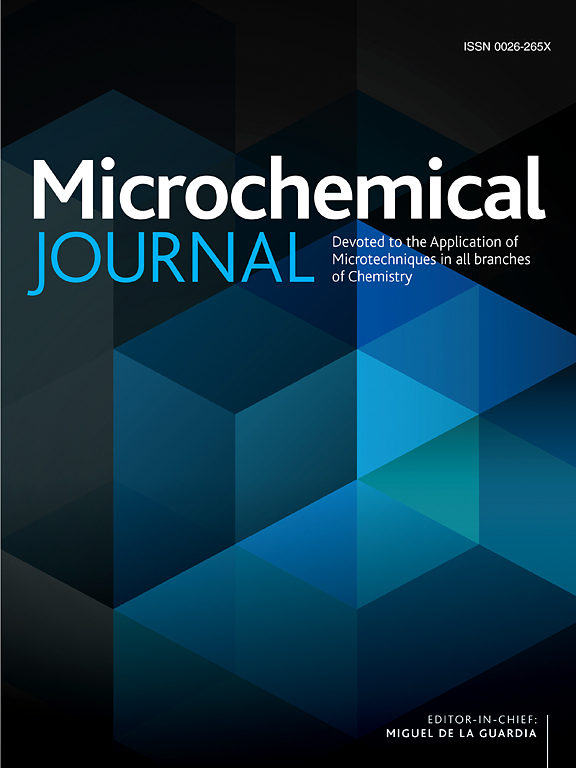Comparison of total phenolic content in organic and conventional carrot under different drying conditions using non-destructive analysis techniques
IF 4.9
2区 化学
Q1 CHEMISTRY, ANALYTICAL
引用次数: 0
Abstract
Current evidence indicates that the higher nutritional value of organic foods, compared to their conventional counterparts, significantly impacts consumer demand. However, the application of thermal processes during processing may lead to a loss of nutritional values, including total phenolics and antioxidants, thereby failing to meet consumer expectations. Phenolics, known as some of the most potent natural antioxidants and are typically assessed through biochemical tests based on the concentration and reactivity of antioxidant compounds. However, the extraction methods can affect the accuracy of phenolic content measurement. In this study, the total phenolic (TP) (mg/100 g) capacity of fresh, hot air (HA)-dried, and intermittent microwave (IMW)-dried organic and conventional black carrots were compared, and the detectability of these compounds using a colorimeter and FT-NIRS was evaluated. PLSR models developed for estimating the TP content using FT-NIRS resulted in successful outcomes (IMW: R2val = 0.78, RMSEP = 51.4 mg/100 g; HA: R2val = 0.70, RMSEP = 63.0 mg/100 g). The highest prediction accuracy was achieved with drying treatments at 300 W (R2val = 0.95, RMSEP = 5.1 mg/100 g) and 450 W (R2val = 0.83, RMSEP = 50.7 mg/100 g), as well as at 80 °C (R2val = 0.90, RMSEP = 21.0 mg/100 g). The drying methods significantly influenced the TP content and the accuracy of TP prediction in samples. Additionally, organic carrots contained a higher level of total phenolic compared to conventional.

用无损分析技术比较不同干燥条件下有机胡萝卜和常规胡萝卜的总酚含量
目前的证据表明,与传统食品相比,有机食品的营养价值更高,这极大地影响了消费者的需求。然而,在加工过程中应用热处理可能导致营养价值的损失,包括总酚类物质和抗氧化剂,从而无法满足消费者的期望。酚类物质被认为是一些最有效的天然抗氧化剂,通常通过基于抗氧化剂化合物的浓度和反应性的生化测试来评估。然而,提取方法会影响测定酚含量的准确性。本研究比较了新鲜、热空气(HA)干燥和间歇微波(IMW)干燥有机黑胡萝卜和常规黑胡萝卜的总酚(TP) (mg/ 100g)容量,并利用比色仪和FT-NIRS对这些化合物的可检出性进行了评价。利用FT-NIRS估计TP含量的PLSR模型取得了成功的结果(IMW: R2val = 0.78, RMSEP = 51.4 mg/100 g;在300 W (R2val = 0.95, RMSEP = 5.1 mg/100 g)、450 W (R2val = 0.83, RMSEP = 50.7 mg/100 g)和80°C (R2val = 0.90, RMSEP = 21.0 mg/100 g)条件下,样品中TP含量和预测精度受到不同干燥方式的显著影响。此外,有机胡萝卜比传统胡萝卜含有更高水平的总酚。
本文章由计算机程序翻译,如有差异,请以英文原文为准。
求助全文
约1分钟内获得全文
求助全文
来源期刊

Microchemical Journal
化学-分析化学
CiteScore
8.70
自引率
8.30%
发文量
1131
审稿时长
1.9 months
期刊介绍:
The Microchemical Journal is a peer reviewed journal devoted to all aspects and phases of analytical chemistry and chemical analysis. The Microchemical Journal publishes articles which are at the forefront of modern analytical chemistry and cover innovations in the techniques to the finest possible limits. This includes fundamental aspects, instrumentation, new developments, innovative and novel methods and applications including environmental and clinical field.
Traditional classical analytical methods such as spectrophotometry and titrimetry as well as established instrumentation methods such as flame and graphite furnace atomic absorption spectrometry, gas chromatography, and modified glassy or carbon electrode electrochemical methods will be considered, provided they show significant improvements and novelty compared to the established methods.
 求助内容:
求助内容: 应助结果提醒方式:
应助结果提醒方式:


